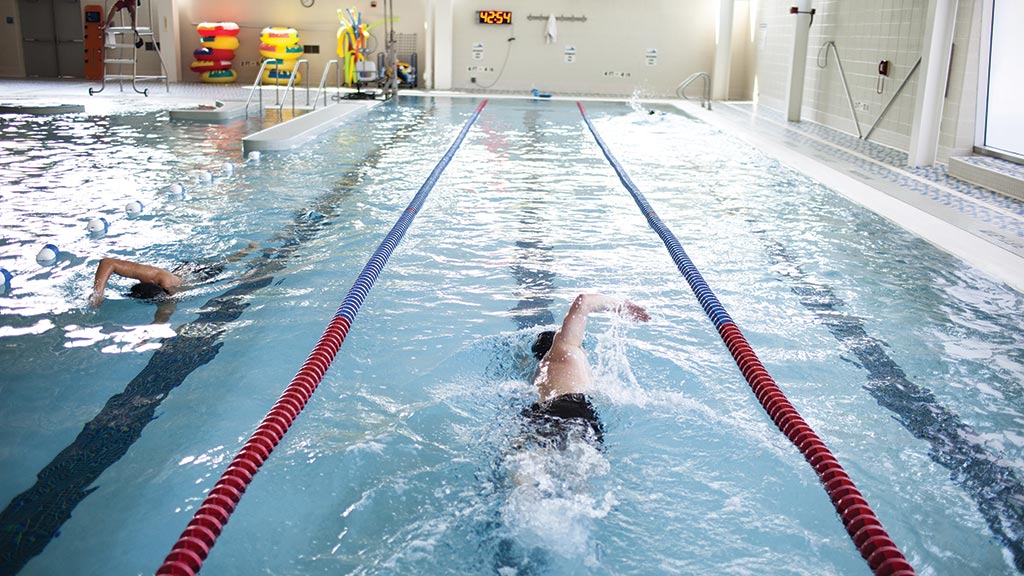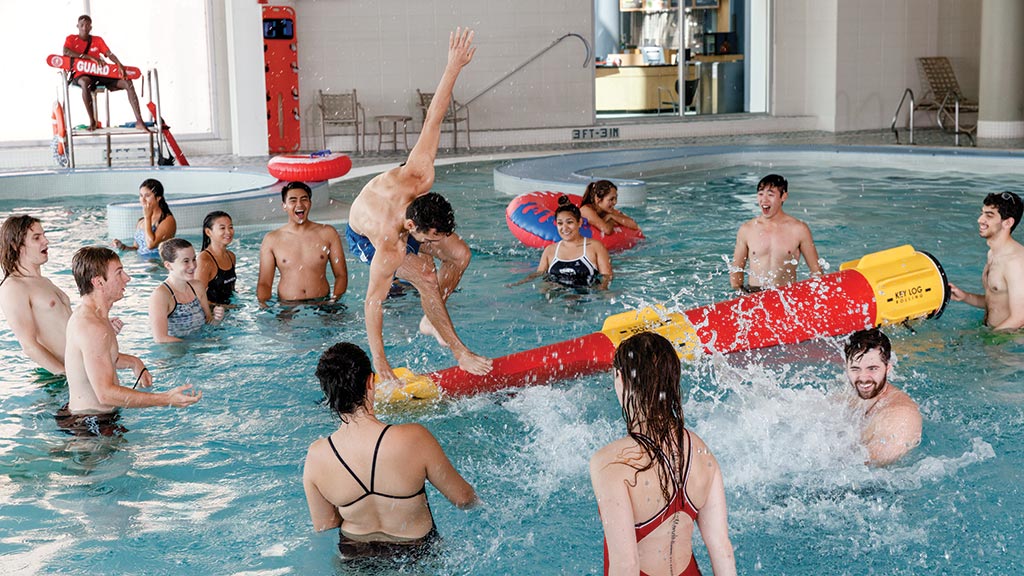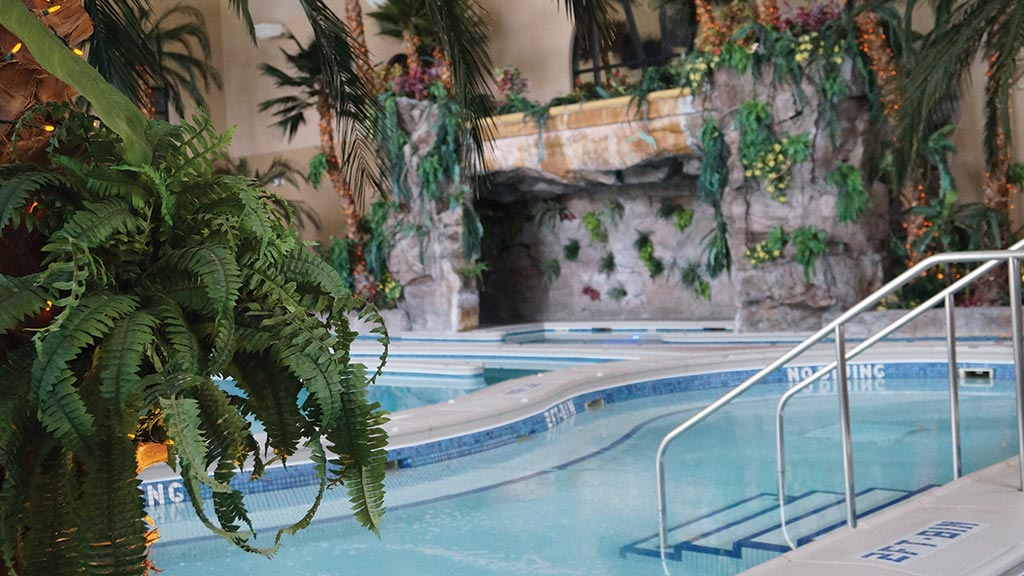One of the shining features of the University of Missouri’s (Mizzou) Student Rec Complex is the aquatics center’s dive tower. Standing 10 meters tall, it has four diving platforms hanging over the 25-yard diving well.
Chris Hull, the assistant director of Aquatics at Mizzou, said the structure is one of the few located throughout the Midwest. Because of this, many dive teams journey to Mizzou’s Rec Complex to compete and practice.
But while the dive tower gives the school national exposure, general users are not allowed on it for safety reasons. This is just one risk management policy Hull helps implement within the aquatics center.
“Aquatics departments come with a lot of risk,” said Hull. “You must look at what you have and prepare for the unexpected. In campus rec, we serve a lot of different groups and all ranges of people. Different things require different focuses.”
Along with the dive tower, Mizzou also has a lazy river, high-powered vortex, waterfall, hot tub and a sauna/steam room. With so many offerings for students, Hull manages the staff with a specific mindset.
“Something I’ve always talked about with my staff is to have a preventative eye,” said Hull. “We have 1.8 million gallons of water and about 150,000 square feet to care for. Utilizing the eyes and the ears of staff is a great support in managing risk at a facility as big as ours. There is looking and there is seeing. Those are two drastically different things. Seeing allows you to take proper preventative actions. In all aspects, we try to promote that.”
Staffing, Signage and More
One risk management policy Hull and his team follows is no aquatics areas can be open without staff present.
Hull said on a typical weekend, over 1,000 users visit the aquatics center. Those numbers created difficulties in previous months due to a national lifeguard shortage brought on by COVID-19.
“We are looking at ways to increase staffing,” said Hull. “Staffing is a huge thing for us to operate safely. This past year we were in a method of recertifying all our staff through the American Red Cross. We are now opening back up to the public for those courses. At this point, we have around six lifeguard instructors in the facility.”
Keeping accurate signage throughout the center is another crucial policy for Hull. For example, one of the pools at Mizzou has a moveable floor that changes swimming depths. Before they convert the depth, they alter the signage to clearly display what the level is before anyone hops in.
Also, Hull said they recently made the switch in PH control from muriatic acid to sodium bisulfate acid for risk purposes. He said it is a safer, less volatile substance. The aquatics center uses the following vendors to ensure all chemicals in the pools are harmless for public usage:
- Pulsar Systems
- BECS Technology
- Evoqua Water Technologies
- Westport Pools
For Hull, risk management comes in the form of having proper equipment. To achieve full ADA compliance, he added they use Spectrum Products’ portable lifts so people of all abilities can safely access the pools.
Adequate apparatuses are also critical at Eastern Washington University (EWU) Campus Rec. Greg Schmidt, the Aquatics Center manager, said they use prototype backboards, designed head immobilizers, NuMask’s patented IntraOral Mask and LIFE Rescue Tubes.
Like at Mizzou, Schmidt said they have mandatory in-service training for lifeguards, and no staff is ever allowed to solo-guard the pool.
EXTRA CREDIT: Four key factors to consider when developing a plan for risk management at aquatics facilities.
“We are very strict about guard/patron ratios and 15-minute rotations to minimize recognition failure,” said Schmidt. “In trainings, I focus on the most difficult scenarios, so the lifeguards get repetitions on the complications associated with those. We also have regular inspections of the facility’s systems to mitigate hazards.”
Similar to Hull, Schmidt also has his own unique mindset when it comes to risk management. “Think like a lawyer,” he advised. “Look at what you’re doing and your equipment, then think how could I represent a plaintiff against us? Also, know what it takes to maintain a lawsuit against you: a duty, a breach of that duty and a measurable loss suffered by the plaintiff.”
One area where that “think like a lawyer” mentality is used at EWU is in the aquatics center’s locker rooms. Schmidt noticed ponding water in the locker rooms were creating a slip hazard. So, he bought matting to cover areas with standing water to eliminate that risk.
Schmidt said he believes the main thing about avoiding liability is knowing the standards in the industry and exceeding them consistently.
Above and Beyond in Safe Aquatics Practices
One way to meet and exceed such standards can be seen at the University of Illinois at Chicago (UIC). Alecia Stegenga, the Aquatics coordinator, said she ensures her facility aligns as closely as possible with all American Red Cross benchmarks.
“I always recommend using the American Red Cross Aquatic Examiner Service,” Stegenga said. “This is an amazing program that can be offered by the American Red Cross or Counsilman-Hunsaker. The program is an extension of education. It’s designed to help educate directors and lifeguards in areas where they don’t align with the benchmarks.”
To better deliver educational programs, Stegenga added they always run a mandatory in-service training before the fall semester begins. This allows UIC Campus Rec to practice and review all lifeguard skills, and it helps staff practice their communication with one another.
“Since many of our staff work in other facilities during the summer, it’s a way for us to review the site-specific aspects of working with our department,” said Stegenga. “We may have different equipment or water features they haven’t worked with for a few months. So, it’s a great refresh of the skills.”
One policy Stegenga leads is they do not offer “free-for-all” open swim for summer day camps that many pools have to accommodate. Instead, if a camp requests time in the facility, UIC provides a group swim lesson to the participants in the program to better guarantee children are supervised on a smaller child-to-adult ratio.
While this does require a staff large enough to meet the needs of kids, this strategy reinforces a common thread echoed by all three aquatics leaders: It takes a village to properly foster a safe environment.
“Don’t be afraid to ask for help or ask for a second opinion,” Stegenga said. “We so often become accidentally complacent with things we have seen repeatedly. It is good to have a fresh set of eyes look at things.”














